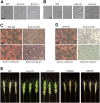The FgNot3 Subunit of the Ccr4-Not Complex Regulates Vegetative Growth, Sporulation, and Virulence in Fusarium graminearum
- PMID: 26799401
- PMCID: PMC4723064
- DOI: 10.1371/journal.pone.0147481
The FgNot3 Subunit of the Ccr4-Not Complex Regulates Vegetative Growth, Sporulation, and Virulence in Fusarium graminearum
Abstract
The Ccr4-Not complex is evolutionarily conserved and important for multiple cellular functions in eukaryotic cells. In this study, the biological roles of the FgNot3 subunit of this complex were investigated in the plant pathogenic fungus Fusarium graminearum. Deletion of FgNOT3 resulted in retarded vegetative growth, retarded spore germination, swollen hyphae, and hyper-branching. The ΔFgnot3 mutants also showed impaired sexual and asexual sporulation, decreased virulence, and reduced expression of genes related to conidiogenesis. Fgnot3 deletion mutants were sensitive to thermal stress, whereas NOT3 orthologs in other model eukaryotes are known to be required for cell wall integrity. We found that FgNot3 functions as a negative regulator of the production of secondary metabolites, including trichothecenes and zearalenone. Further functional characterization of other components of the Not module of the Ccr4-Not complex demonstrated that the module is conserved. Each subunit primarily functions within the context of a complex and might have distinct roles outside of the complex in F. graminearum. This is the first study to functionally characterize the Not module in filamentous fungi and provides novel insights into signal transduction pathways in fungal development.
Conflict of interest statement
Figures









Similar articles
-
FgFlbD regulates hyphal differentiation required for sexual and asexual reproduction in the ascomycete fungus Fusarium graminearum.J Microbiol. 2014 Nov;52(11):930-9. doi: 10.1007/s12275-014-4384-6. Epub 2014 Oct 3. J Microbiol. 2014. PMID: 25277408
-
Functional characterization of FgERG3 and FgERG5 associated with ergosterol biosynthesis, vegetative differentiation and virulence of Fusarium graminearum.Fungal Genet Biol. 2014 Jul;68:60-70. doi: 10.1016/j.fgb.2014.04.010. Epub 2014 Apr 29. Fungal Genet Biol. 2014. PMID: 24785759
-
AbaA regulates conidiogenesis in the ascomycete fungus Fusarium graminearum.PLoS One. 2013 Sep 10;8(9):e72915. doi: 10.1371/journal.pone.0072915. eCollection 2013. PLoS One. 2013. PMID: 24039821 Free PMC article.
-
Recent advances in genes involved in secondary metabolite synthesis, hyphal development, energy metabolism and pathogenicity in Fusarium graminearum (teleomorph Gibberella zeae).Biotechnol Adv. 2014 Mar-Apr;32(2):390-402. doi: 10.1016/j.biotechadv.2013.12.007. Epub 2014 Jan 2. Biotechnol Adv. 2014. PMID: 24389085 Review.
-
Fungal Cytochrome P450s and the P450 Complement (CYPome) of Fusarium graminearum.Toxins (Basel). 2018 Mar 7;10(3):112. doi: 10.3390/toxins10030112. Toxins (Basel). 2018. PMID: 29518888 Free PMC article. Review.
Cited by
-
MoNOT3 Subunit Has Important Roles in Infection-Related Development and Stress Responses in Magnaporthe oryzae.Int J Mol Sci. 2024 Mar 14;25(6):3290. doi: 10.3390/ijms25063290. Int J Mol Sci. 2024. PMID: 38542264 Free PMC article.
-
CCR4-Not Complex Subunit Not2 Plays Critical Roles in Vegetative Growth, Conidiation and Virulence in Watermelon Fusarium Wilt Pathogen Fusarium oxysporum f. sp. niveum.Front Microbiol. 2016 Sep 16;7:1449. doi: 10.3389/fmicb.2016.01449. eCollection 2016. Front Microbiol. 2016. PMID: 27695445 Free PMC article.
-
Roles of the CCR4-Not complex in translation and dynamics of co-translation events.Wiley Interdiscip Rev RNA. 2023 Nov 27;15(1):e1827. doi: 10.1002/wrna.1827. Online ahead of print. Wiley Interdiscip Rev RNA. 2023. PMID: 38009591 Free PMC article. Review.
-
The Non-Histone Protein FgNhp6 Is Involved in the Regulation of the Development, DON Biosynthesis, and Virulence of Fusarium graminearum.Pathogens. 2024 Jul 16;13(7):592. doi: 10.3390/pathogens13070592. Pathogens. 2024. PMID: 39057819 Free PMC article.
-
Utilization of a Conidia-Deficient Mutant to Study Sexual Development in Fusarium graminearum.PLoS One. 2016 May 13;11(5):e0155671. doi: 10.1371/journal.pone.0155671. eCollection 2016. PLoS One. 2016. PMID: 27175901 Free PMC article.
References
-
- Sutton J. Epidemiology of wheat head blight and maize ear rot caused by Fusarium graminearum. Can J Plant Pathol. 1982; 4: 195–209.
-
- Desjardins AE. Fusarium mycotoxins: chemistry, genetics, and biology. St Paul, MN: American Phytopathological Society Press; 2006.
-
- Leslie JF, Summerell BA, Bullock S. The Fusarium laboratory manual. vol 10 Ames, IA: Blackwee Pub; 2006.
-
- Guenther JC, Trail F. The development and differentiation of Gibberella zeae (anamorph: Fusarium graminearum) during colonization of wheat. Mycologia. 2005; 97: 229–237. - PubMed
Publication types
MeSH terms
Substances
LinkOut - more resources
Full Text Sources
Other Literature Sources

